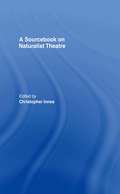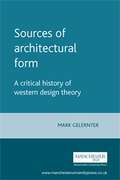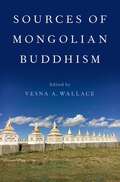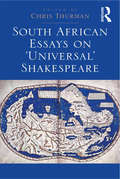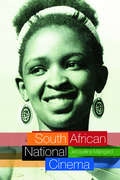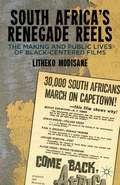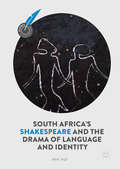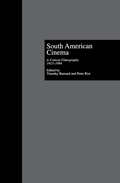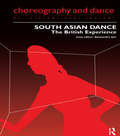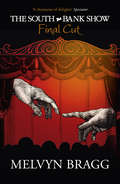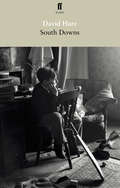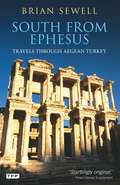- Table View
- List View
A Sourcebook on Naturalist Theatre
by Christopher InnesA Sourcebook on Naturalist Theatre provides essential primary sources which document one of the key movements in modern theatre. Christopher Innes has selected three writers to exemplify the movement, and six plays in particular: * Henrik Ibsen - A Dolls House and Hedda Gabler * Anton Chekhov - The Seagull and The Cherry Orchard * George Bernard Shaw - Mrs Warren's Profession and Heartbreak House. Innes' introduction provides an overview of naturalist theatre. Key themes include: the representation of women, significant contemporary issues and the links between theory, play writing and stage practice. The primary sources explore many aspects of naturalism, giving information on: * the playwrights' intentions when writing plays * contemporary reviews * literary criticism * political and social background * production notes from early performances of the plays.
Sources Of Architectural Form: A Critical History Of Western Design Theory (Manchester University Press Ser. (PDF))
by Mark GelernterSources of Architectural Form provides a critical history of Western architecture theory from the ancient world to the present day. It focuses on design theory's central question: how does the architect generate architectural form? Theorists necessarily tackle this fundamental question in order to explain a number of puzzling issues including the origins of style, the persistence of tradition and the role of genius.This book describes the major design theories in eight chronological periods, conveying their flavour with contemporary quotations. Each theory is analysed for its strengths and weaknesses. Gelernter identifies an important relationship between theories of design and theories of knowledge, and so explains and analyses each period's dominant epistemological concepts. Contemporary theorists of education are also examined, as many theorists from Vitruvius to Gropius included precepts for teaching as integral components of their ideas.
Sources of Mongolian Buddhism
by Vesna A. WallaceDespite Mongolia's centrality to East Asian history and culture, Mongols themselves have often been seen as passive subjects on the edge of the Qing formation or as obedient followers of so-called "Tibetan Buddhism," peripheral to major literary, religious, and political developments. But in fact Mongolian Buddhists produced multi-lingual and genre-bending scholastic and ritual works that profoundly shaped historical consciousness, community identification, religious knowledge, and practices in Mongolian lands and beyond. In Sources of Mongolian Buddhism, a team of leading Mongolian scholars and authors have compiled a collection of original Mongolian Buddhist works--including ritual texts, poetic prayers and eulogies, legends, inscriptions, and poems--for the first time in any European language.
Sources of Mongolian Buddhism
Despite Mongolia's centrality to East Asian history and culture, Mongols themselves have often been seen as passive subjects on the edge of the Qing formation or as obedient followers of so-called "Tibetan Buddhism," peripheral to major literary, religious, and political developments. But in fact Mongolian Buddhists produced multi-lingual and genre-bending scholastic and ritual works that profoundly shaped historical consciousness, community identification, religious knowledge, and practices in Mongolian lands and beyond. In Sources of Mongolian Buddhism, a team of leading Mongolian scholars and authors have compiled a collection of original Mongolian Buddhist works--including ritual texts, poetic prayers and eulogies, legends, inscriptions, and poems--for the first time in any European language.
Sourcing and Selecting Textiles for Fashion (Required Reading Range)
by Erin CadiganWritten with the innovative fashion student in mind, Sourcing and Selecting Textiles for Fashion gives a full overview of the current textile market and shows how to apply this knowledge when creating a fashion collection. Following a brief look at the historical growth of fashion textiles in industry and culture, the book explores the manufacturing, design, sourcing and end-use of fashion textiles. Natural and man-made fibres are discussed along with current woven, knit and non-woven production methods. A variety of industrial and custom surface design techniques including dye, print, embellishment and fabric manipulation are covered. Trend, inspiration, colour, creating the collection and how to enhance design through textile choice and surface design are included. A perspective of current innovation and sustainability is offered in each area.Colour photographs, illustrations and designer spotlights supplement informative text throughout the book, and the text includes a bonus section of interviews with designers at different levels of their career and marketplace, focusing on how they select and source fabrics and apply them to their designs.
Sourcing Ideas for Textile Design: Researching Colour, Surface, Structure, Texture and Pattern (Basics Textile Design)
by Josephine Steed Frances StevensonA visual goldmine for designers of original print, weave and embellishment, Sourcing Ideas for Textile Design will help you generate new ideas, develop them methodically and finally create beautifully designed textiles. The carefully selected range of images illustrate how to use visual information in this process from a variety of sources, breaking down the process into key themes – colour, surface, structure, texture and pattern. This second edition includes:· case studies and interviews with insight into visual research and development from revered practising designers, including Dries Van Noten and Reiko Sudo;· Spotlight sections offer historical or cultural perspectives on each point in the process; and,· new coverage of material investigation, colour analysis, presentation and curation, as well as advice on IP and copyright. You'll also be guided through the three stages of textile design where you will:· generate your idea; · work to develop it; and, · create your developed idea in the studio. By engaging with this approach, and exploring new ways of seeing ordinary things through the key themes, you'll learn to create incredible effects in your textile design.
Sourcing Ideas for Textile Design: Researching Colour, Surface, Structure, Texture and Pattern (Basics Textile Design)
by Josephine Steed Frances StevensonA visual goldmine for designers of original print, weave and embellishment, Sourcing Ideas for Textile Design will help you generate new ideas, develop them methodically and finally create beautifully designed textiles. The carefully selected range of images illustrate how to use visual information in this process from a variety of sources, breaking down the process into key themes – colour, surface, structure, texture and pattern. This second edition includes:· case studies and interviews with insight into visual research and development from revered practising designers, including Dries Van Noten and Reiko Sudo;· Spotlight sections offer historical or cultural perspectives on each point in the process; and,· new coverage of material investigation, colour analysis, presentation and curation, as well as advice on IP and copyright. You'll also be guided through the three stages of textile design where you will:· generate your idea; · work to develop it; and, · create your developed idea in the studio. By engaging with this approach, and exploring new ways of seeing ordinary things through the key themes, you'll learn to create incredible effects in your textile design.
South African Essays on 'Universal' Shakespeare
by Chris ThurmanSouth African Essays on ’Universal’ Shakespeare collects new scholarship and extant (but previously unpublished) material, reflecting the changing nature of Shakespeare studies across various ’generation gaps’. Each essay, in exploring the nuances of Shakespearean production and reception across time and space, is inflected by a South African connection. In some cases, this is simply because of the author’s nationality or institutional affiliation; in others, there is a direct engagement with what Shakespeare means, or has meant, in South Africa. By investigating the universality of Shakespeare from both implicitly and explicitly ’southern’ perspectives, the book presents new possibilities for considering (and reassessing) shifting manifestations of Shakespeare’s work in major Shakespearean ’centres’ such as Britain and the United States, as well as across the global North and South.
South African Essays on 'Universal' Shakespeare
by Chris ThurmanSouth African Essays on ’Universal’ Shakespeare collects new scholarship and extant (but previously unpublished) material, reflecting the changing nature of Shakespeare studies across various ’generation gaps’. Each essay, in exploring the nuances of Shakespearean production and reception across time and space, is inflected by a South African connection. In some cases, this is simply because of the author’s nationality or institutional affiliation; in others, there is a direct engagement with what Shakespeare means, or has meant, in South Africa. By investigating the universality of Shakespeare from both implicitly and explicitly ’southern’ perspectives, the book presents new possibilities for considering (and reassessing) shifting manifestations of Shakespeare’s work in major Shakespearean ’centres’ such as Britain and the United States, as well as across the global North and South.
South African National Cinema (National Cinemas)
by Jacqueline MaingardSouth African National Cinema examines how cinema in South Africa represents national identities, particularly with regard to race. This significant and unique contribution establishes interrelationships between South African cinema and key points in South Africa’s history, showing how cinema figures in the making, entrenching and undoing of apartheid. This study spans the twentieth century and beyond through detailed analyses of selected films, beginning with De Voortrekkers (1916) through to Mapantsula (1988) and films produced post apartheid, including Drum (2004), Tsotsi (2005) and Zulu Love Letter (2004). Jacqueline Maingard discusses how cinema reproduced and constructed a white national identity, taking readers through cinema’s role in building white Afrikaner nationalism in the 1930s and 1940s. She then moves to examine film culture and modernity in the development of black audiences from the 1920s to the 1950s, especially in a group of films that includes Jim Comes to Joburg (1949) and Come Back, Africa (1959). Jacqueline Maingard also considers the effects of the apartheid state’s film subsidy system in the 1960s and 1970s and focuses on cinema against apartheid in the 1980s. She reflects upon shifting national cinema policies following the first democratic election in 1994 and how it became possible for the first time to imagine an inclusive national film culture. Illustrated throughout with excellent visual examples, this cinema history will be of value to film scholars and historians, as well as to practitioners in South Africa today.
South African National Cinema (National Cinemas)
by Jacqueline MaingardSouth African National Cinema examines how cinema in South Africa represents national identities, particularly with regard to race. This significant and unique contribution establishes interrelationships between South African cinema and key points in South Africa’s history, showing how cinema figures in the making, entrenching and undoing of apartheid. This study spans the twentieth century and beyond through detailed analyses of selected films, beginning with De Voortrekkers (1916) through to Mapantsula (1988) and films produced post apartheid, including Drum (2004), Tsotsi (2005) and Zulu Love Letter (2004). Jacqueline Maingard discusses how cinema reproduced and constructed a white national identity, taking readers through cinema’s role in building white Afrikaner nationalism in the 1930s and 1940s. She then moves to examine film culture and modernity in the development of black audiences from the 1920s to the 1950s, especially in a group of films that includes Jim Comes to Joburg (1949) and Come Back, Africa (1959). Jacqueline Maingard also considers the effects of the apartheid state’s film subsidy system in the 1960s and 1970s and focuses on cinema against apartheid in the 1980s. She reflects upon shifting national cinema policies following the first democratic election in 1994 and how it became possible for the first time to imagine an inclusive national film culture. Illustrated throughout with excellent visual examples, this cinema history will be of value to film scholars and historians, as well as to practitioners in South Africa today.
South African performance and archives of memory (Theatre: Theory – Practice – Performance)
by Yvette HutchisonThis book explores how South Africa is negotiating its past in and through various modes of performance in contemporary theatre, public events and memorial spaces. It analyses the Truth and Reconciliation Commission as a live event, as an archive, and in various theatrical engagements with it, asking throughout how the TRC has affected the definition of identity and memory in contemporary South Africa, including disavowed memories. Hutchison then considers how the SA-Mali Timbuktu Manuscript Project and the 2010 South African World Cup opening ceremony attempted to restage the nation in their own ways. She investigates how the Voortrekker Monument and Freedom Park embody issues related to memory in contemporary South Africa. She also analyses current renegotiations of popular repertoires, particularly songs and dances related to the Struggle, revivals of classic European and South African protest plays, new history plays and specific racial and ethnic histories and identities.
South African performance and archives of memory (Theatre: Theory – Practice – Performance)
by Yvette HutchisonThis book explores how South Africa is negotiating its past in and through various modes of performance in contemporary theatre, public events and memorial spaces. It analyses the Truth and Reconciliation Commission as a live event, as an archive, and in various theatrical engagements with it, asking throughout how the TRC has affected the definition of identity and memory in contemporary South Africa, including disavowed memories. Hutchison then considers how the SA-Mali Timbuktu Manuscript Project and the 2010 South African World Cup opening ceremony attempted to restage the nation in their own ways. She investigates how the Voortrekker Monument and Freedom Park embody issues related to memory in contemporary South Africa. She also analyses current renegotiations of popular repertoires, particularly songs and dances related to the Struggle, revivals of classic European and South African protest plays, new history plays and specific racial and ethnic histories and identities.
South Africa's Renegade Reels: The Making and Public Lives of Black-Centered Films
by L. ModisaneDespite incredible political upheavals and a minimal national history of film production, movies such as Come Back, Africa (1959), uDeliwe (1975), and Fools (1998) have taken on an iconic status within South African culture. In this much-needed study, author Litheko Modisane delves into the public critical engagements around old 'renegade' films and newer ones, revealing instructive details both in the production and the public lives of South African movies oriented around black social experiences. This illuminates the complex nature of cinema in modern public life, enriching established methodologies by expanding the cultural and conceptual boundaries of film as a phenomenon of textual circulation.
South Africa's Shakespeare and the Drama of Language and Identity (Global Shakespeares)
by Adele SeeffThis volume considers the linguistic complexities associated with Shakespeare’s presence in South Africa from 1801 to early twentieth-first century televisual updatings of the texts as a means of exploring individual and collective forms of identity. A case study approach demonstrates how Shakespeare’s texts are available for ideologically driven linguistic programs. Seeff introduces the African Theatre, Cape Town, in 1801, multilingual site of the first recorded performance of a Shakespeare play in Southern Africa where rival, amateur theatrical groups performed in turn, in English, Dutch, German, and French. Chapter 3 offers three vectors of a broadening Shakespeare diaspora in English, Afrikaans, and Setswana in the second half of the nineteenth century. Chapter 4 analyses André Brink’s Kinkels innie Kabel, a transposition of Shakespeare’s The Comedy of Errors into Kaaps, as a radical critique of apartheid’s obsession with linguistic and ethnic purity. Chapter 5 investigates John Kani’s performance of Othello as a Xhosa warrior chief with access to the ancient tradition of Xhosa storytellers. Shakespeare in Mzansi, a televisual miniseries uses black actors, vernacular languages, and local settings to Africanize Macbeth and reclaim a cross-cultural, multilingualism. An Afterword assesses the future of Shakespeare in a post-rainbow, decolonizing South Africa. Global Sha Any reader interested in Shakespeare Studies, global Shakespeare, Shakespeare in performance, Shakespeare and appropriation, Shakespeare and language, Literacy Studies, race, and South African cultural history will be drawn to this book.
South Africa's Shakespeare and the Drama of Language and Identity (Global Shakespeares)
by Adele SeeffThis volume considers the linguistic complexities associated with Shakespeare’s presence in South Africa from 1801 to early twentieth-first century televisual updatings of the texts as a means of exploring individual and collective forms of identity. A case study approach demonstrates how Shakespeare’s texts are available for ideologically driven linguistic programs. Seeff introduces the African Theatre, Cape Town, in 1801, multilingual site of the first recorded performance of a Shakespeare play in Southern Africa where rival, amateur theatrical groups performed in turn, in English, Dutch, German, and French. Chapter 3 offers three vectors of a broadening Shakespeare diaspora in English, Afrikaans, and Setswana in the second half of the nineteenth century. Chapter 4 analyses André Brink’s Kinkels innie Kabel, a transposition of Shakespeare’s The Comedy of Errors into Kaaps, as a radical critique of apartheid’s obsession with linguistic and ethnic purity. Chapter 5 investigates John Kani’s performance of Othello as a Xhosa warrior chief with access to the ancient tradition of Xhosa storytellers. Shakespeare in Mzansi, a televisual miniseries uses black actors, vernacular languages, and local settings to Africanize Macbeth and reclaim a cross-cultural, multilingualism. An Afterword assesses the future of Shakespeare in a post-rainbow, decolonizing South Africa. Global Sha Any reader interested in Shakespeare Studies, global Shakespeare, Shakespeare in performance, Shakespeare and appropriation, Shakespeare and language, Literacy Studies, race, and South African cultural history will be drawn to this book.
South American Cinema: A Critical Filmography, l915-l994
by Timothy Barnard Peter RistFirst Published in 1996. Routledge is an imprint of Taylor & Francis, an informa company.
South American Cinema: A Critical Filmography, l915-l994 (Historical Dictionaries Of Literature And The Arts Ser.)
by Timothy Barnard Peter RistFirst Published in 1996. Routledge is an imprint of Taylor & Francis, an informa company.
South Asian Dance: The British Experience
by Alessandra IyerFirst Published in 1998. Routledge is an imprint of Taylor & Francis, an informa company.
South Asian Dance: The British Experience
by Alessandra IyerFirst Published in 1998. Routledge is an imprint of Taylor & Francis, an informa company.
South Bank: Architecture & Design
by Dominic BradburyArchitecture and design specialist Dominic Bradbury draws back the curtain on the iconic South Bank, providing an unrivalled insight into the buildings that populate one of London's epicentres of art and entertainment. Encompassing an art gallery, theatres, festival halls and a cinema, the South Bank is a cultural hub in the heart of London. South Bank: Architecture & Design is a beautifully crafted celebration of its sublime, community-focused architecture. The book opens with an origin story, unravelling the evolution of this riverside enclave since the 1951 Festival of Britain catapulted it onto the scene and exploring the renowned architects and designers that have shaped this space throughout the mid-century and beyond. Much of the book is devoted to the buildings themselves, all of which are accompanied by Bradbury's authoritative text and richly illustrated with photography by Rachael Smith. The buildings include: • Royal Festival Hall • Hayward Gallery • Queen Elizabeth Hall and The Purcell Room • National Film Theatre/BFI • National Theatre This sumptuous book is an invaluable purchase for anyone intrigued by our built heritage and cultural spaces.
The South Bank Show: Final Cut
by Melvyn BraggWhat drives a musician to write extraordinary songs? How do writers create their worlds? How does an actor achieve greatness?For over thirty years of The South Bank Show, Melvyn Bragg has interviewed many of the greatest cultural icons of our age. These interviews offer revelatory insights into the lives and work of writers, actors, artists and musicians. In The South Bank Show: Final Cut he has revisited some of these artists and used the interviews as the basis for fuller portraits.The range of artists is remarkable and this book is true to The South Bank Show’s ethos of seeking out the highest quality whatever the art form.Melvyn Bragg’s unique perspective makes this book indispensable for anyone interested in the work and lives of some of the best artists of our time.
South Downs and Mere Fact, Mere Fiction
by David HareJohn Blakemore is a solitary boy who finds it impossible either to understand or adapt to the ways of the school. His adolescent earnestness put off teacher and pupil alike. And now suddenly he seems to be in danger of losing his only friend.David Hare's emotional new play, written at the invitation of the Rattigan estate as a response to The Browning Version, is a meditation on faith, learning and teenage friendship, played against the backdrop of a Britain still fighting to maintain an established rule.Collected with South Downs is the text of Hare's lecture Mere Fact, Mere Fiction, delivered to the Royal Society of Literature in 2010. In a famous defence of documentary theatre, the author celebrates the power of metaphor to transform factual quite as much as fictional material.
South East Entrance Gates (SEB)
by RnibThis is a memorial to Godfrey Sykes (1824-1866) one of Sheffield’s famous craftsmen. The tactile image shows the basic shape of the memorial with the bronze relief and three main bands of decoration shown as textures. The metal railings have been shown with the base of the memorial behind them omitted. This monument is by James Gamble and based on some of Sykes' own designs. It was erected in the park in 1875. Terracotta was used to make the original gateways to the park at Winter Street and Western Bank. The Winter Street gateway and lodge were demolished in 1952 in order to construct the University Library. The Western Bank gateway can still be found at location 6 (South East Entrance Gates) of this tour.
South from Ephesus: Travels through Aegean Turkey
by Brian SewellWeary of what he called the "tyranny" of western art, Brian Sewell first visited Turkey - a country that had captivated him since he was a boy - in 1975. He thought that there, anything he found would have no relevance to the European art that he had so compulsively "stitched into the dense fabric of my art-historical memory" and that he could therefore enjoy the art for its own sake. But Turkey surprised him and he delighted in the unexpected wealth of Greek, Roman, Byzantine and Islamic cultures there, returning three of four times a year until 1990. The main bulk of this book focuses on his journey from Ephesus to Side one winter. With typically acerbic commentary, Sewell describes (not always favourably) the archaeological and historical sites he comes across, the landscapes that so clearly thrilled him, the encounters he has along the way and the fractious, though wonderfully funny, relationship he forms with Ayhan, his driver. South from Ephesus is an incomparable portrait of Turkey and its artistic heritage - a book that could only have been written by Sewell and which has become a quirky classic of travel literature.
